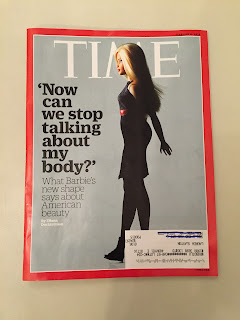Off the bat, I’ll say I wasn’t a doll girl growing up. I did
have a Cabbage Patch but that was more of a stuffed animal and 80s status
symbol (among the 4th graders). I spent time with Speak & Math
the way some of my friends played dolls. I recall some limited Barbie play at
two friend’s houses but I was much more interested in Barbie’s dream house. So,
I don’t have any sentimental connection to the iconic doll.
If you haven’t heard, there are three new Barbies on the
block. They’re all named Barbie but there are petite, curvy and tall versions.
There are new skin tones and hair colors and textures as well. Mattel, who
makes Barbie, says they hope the new dolls will be a reflection of the young
owner’s world. They also hope to save Barbie from decreasing sales.
Barbie is on the cover of Time this week. The Time article mentions Kim Kardashian, Beyoncé
and Lena Dunham as examples of changing beauty ideals and thus the need for
newly shaped Barbies. I could be wrong but I wouldn’t peg Lena the
Barbie-playing type. No matter what the body type, the message is still it’s
all about Barbie’s body. It’s superficial and judgmental to say “curvy is the
new thin”.
If we trace Barbie’s roots, her body is based on a German
doll called Lilli. Lilli was a “prostitute gag gift handed out at bachelor
parties.” I am not sure how the doll made the leap from hooker to toy aisle but
we can’t blame Barbie for that. Barbie
has quite a checkered past, there was a teen Barbie grasping a diet book with
the advice “don’t eat”. I can only imagine what the parents, who send Mattel’s
COO death treats, would have to say about eating disorder Barbie.
I’m not entirely convinced that a doll’s body affects what
young girls think about their bodies. After all, I felt no surge in desire to
have the Cabbage Patch body. Time references
a 2006 study and reports “girls exposed to Barbie at a young age expressed
greater concern with being thin.” I looked at this study and this wasn’t
necessarily conducted on Barbie lovers, rather girls were shown images of
various dolls. So I don’t know if Barbie is harmful.
And who am I to pass judgment on Barbie or parents who are
up in arms about Barbie’s body? Look what’s going on in my house.
What do you think of
the new Barbies? Is this an indicator of inclusivity or a marketing ploy? Do
you think Barbie affects the way young girls (or boys) think about their
bodies?
*And the winner of our Four Sigma giveaway is Erica Sara.








No comments:
Post a Comment